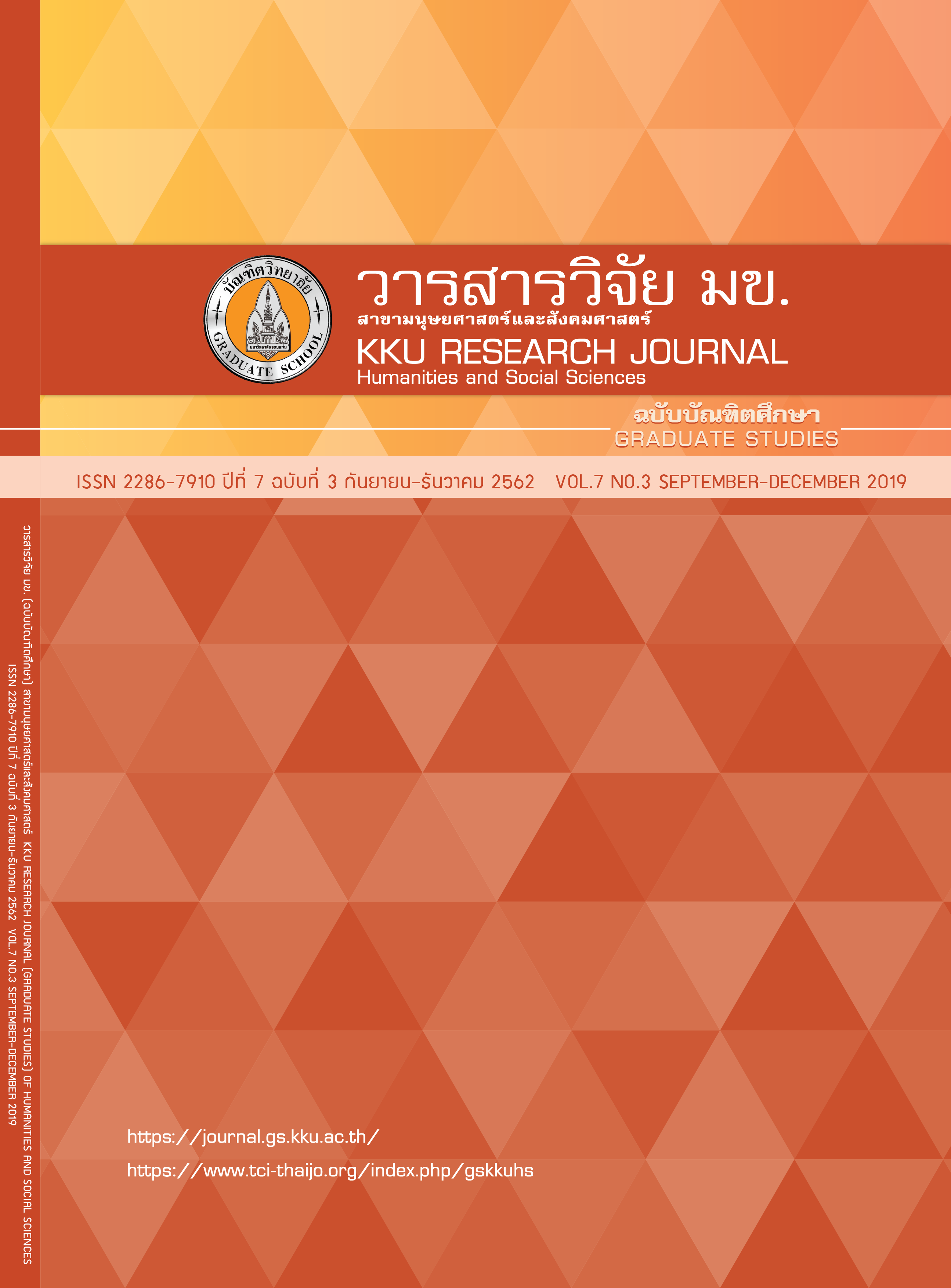Test of the Day-of-the-Week Effect on Stock Market Volatility: The Case of the SET50 Index
Keywords:
Day-of-the-week effect, Volatility, Stock marketAbstract
Purpose of this research is to study the effect of the day of week on stock market volatility in case of SET50 index. The study includes an analysis of time series by using the daily data; Monday, Tuesday, Wednesday, Thursday and Friday. Data are the closing prices of the SET and were collected from July 1, 2013 to June 30, 2016 to tally 733 days. The results of unit root test by using Augmented Dickey-Fuller (ADF) test indicate that the data are stationary at the first difference. Further, those data were examined by statistical analysis i.e. OLS, GARCH(1,1), GARCH-M(1,1), EGARCH(1,1), TGARCH(1,1) and PARCH(1,1) models. The OLS and PARCH models reflect the day of week effect. The OLS find negative return on Monday but positive return on Wednesday. While the PARCH(1,1) find negative return on Monday but positive return on Friday. The results from the rest models are not significant. Model adequacy using the Akaike information criterion (AIC) and the Schwarz criterion (SIC) are considered. The results show that the PARCH(1,1) is the best model because of its lowest AIC and SIC values relative to another model. Investors may use the investment plan to maximize efficiency. Morover, the regulators can use the information to prevent the excess profits in the market. This will prevent some investors from gaining advantage in the information that will bring about the efficiency of the market.
References
House; 2004. Thai.
2. Thailand Securities Institute. Financial market and security investment.
12th ed. Bangkok: Stock Exchange of Thailand; 2001. Thai.
3. Fama EF. Efficient capital markets: A review of theory and empirical
work. Journal of Finance. 1970; 25(2): 383-417.
4. Charles A. The day-of-the-week effects on the volatility: The role of
the asymmetry. European Journal of Operational Research. 2010;
202(1): 143-52.
5. Dubois M, Louvet P. The day-of-the-week effect: The international
evidence. Journal of Banking & Finance. 1996; 20(9): 1463-84.
6. Kiymaz H, Berument H. The day of the week effect on stock market
volatility and volume: International evidence. Review of Financial
Economics. 2003; 12(4): 363-80.
7. Chen G, Kwok CCY, Rui OM. The day-of-the-week regularity in
the stock markets of China. Journal of Multinational Financial
Management. 2001; 11(2): 139-63.
8. Cai J, Li Y, Qi Y. The day-of-the-week effect: New evidence from
the Chinese stock market. The Chinese Economy. 2006; 39(2): 71-88.
9. Anwar Y, Mulyadi MS. Analysis of calendar effects: Day-of-the-week
effects in Indonesia, Singapore, and Malaysia stock markets. African
Journal of Business Management. 2012; 6(11): 3880-7.
10. Zhang J, Lai Y, Lin J. The day-of-the-week effects of stock markets
in different countries. Finance Research Letters. 2017; 20: 47-62.
11. Pettengill GN. A survey of the Monday effect literature. Quarterly
Journal of Business and Economics. 2003; 42(3/4): 3-27.
12. Brooks C, Persand G. Seasonality in Southeast Asian stock markets:
Some new evidence on day-of-the-week effects. Applied Economics
Letters. 2001; 8(3): 155-8.
13. Holden K, Thompson J, Ruangrit Y. The Asian crisis and calendar
effects on stock returns in Thailand. European Journal of Operational
Research. 2005; 163(1): 242-52.
14. Parkatt G. Testing of seasonal behavior “day-of-the-week effect”
in the stock market. Suranaree Journal of Scocial Science. 2016;
10(1): 139-52. Thai.
15. Engle RF, Lilien DM, Robins RP. Estimating time varying risk premia
in the term structure: The ARCH-M model. Econometrica. 1987; 55(2):
391-407.
16. Glosten LR, Jagannathan R, Runkle DE. On the relation between
the expected value and the volatility of the nominal excess return on
stocks. The Journal of Finance. 1993; 48(5): 1779-801.
17. Dickey DA, Fuller WA. Distribution of the estimators for
autoregressive time series with a unit root. Journal of the
American Statistical Association. 1979; 74(366): 427-31.
18. Said SE, Dickey DA. Testing for unit roots in autoregressive-moving
average models of unknown order. Biometrika. 1984; 71(3): 599-607.
19. Gibbons MR, Hess P. Day of the week effects and asset returns.
The Journal of Business. 1981; 54(4): 579-96.
20. Bollerslev T. Generalized autoregressive conditional
heteroskedasticity. Journal of Econometrics. 1986; 31(3): 307-27.
21. Engle RF. Autoregressive conditional heteroscedasticity with
estimates of the variance of United Kingdom inflation. Econometrica.
1982; 50(4): 987-1008.
22. Box GEP, Jenkins GM, Reinsel GC. Time series analysis:
Forecasting and control. 4th ed. Hoboken, NJ: Wiley; 2008.
23. Nelson DB. Conditional heteroskedasticity in asset returns:
A new approach. Econometrica. 1991; 59(2): 347-70.
24. Zakoian J-M. Threshold heteroskedastic models. Journal of Economic
Dynamics and Control. 1994; 18(5): 931-55.
25. Ding Z, Granger CWJ, Engle RF. A long memory property of stock
market returns and a new model. Journal of Empirical Finance. 1993;
1(1): 83-106.
26. Tangjitprom N. Preholiday returns and volatility in the Thai
stock market. Asian Journal of Finance & Accounting. 2010; 2(2):
41-54.
27. Hansen PR, Lunde A. A forecast comparison of volatility models:
Does anything beat a GARCH(1,1)? Journal of Applied Econometrics.
2005; 20(7): 873-89.
28. MacKinnon JG. Numerical distribution functions for unit root and
cointegration tests. Journal of Applied Econometrics. 1996; 11(6): 601-18.




